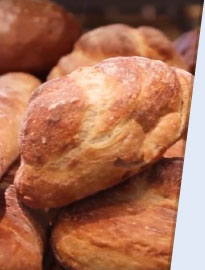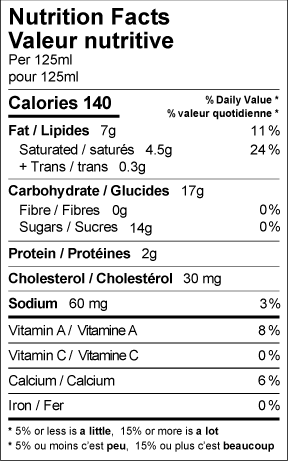Registered Dietitian Margaret Brum suggests some ways you can manage the added sugars in your diet.
The American Heart Association defines added sugars as: “sugars and syrups put in foods during preparation or processing, or added at the table”1. High sugar intake from added sugars is linked to high triglyceride levels. High triglyceride levels in the blood increase the risk of diabetes and heart disease.
Foods that naturally contain sugars, like fruit, vegetables, milk, and whole grains, are healthy choices. These foods are recommended as part of a healthy diet.
The World Health Organization, the Canadian Diabetes Association and the American Heart Association recommend adults consume less than 10% of total calories from added or free sugars2. Free sugars include all added sugars plus sugars naturally present in honey, fruit juices and syrups.
- For women, this means having less than 24 grams (6 teaspoons or 100 calories) of added sugars each day
- For men, this means having less than 36 grams (9 teaspoons or 150 calories) of added sugars each day
How Do I Reduce Added Sugars In My Diet?

 Find how to choose healthy cereal, bread and more
View Videos
Find how to choose healthy cereal, bread and more
View Videos
- Replace sugary drinks (e.g. regular soda, iced tea, juices, fruit drinks, sports drinks, energy drinks, etc.) with water, unsweetened herbal tea, reduced fat milk, or unsweetened soy, rice or almond milk.
- Add flavour to foods and drinks by using spices (e.g. ginger, cinnamon, nutmeg, vanilla extract) instead of sugar.
- Choose plain yogurt instead of fruit or flavoured sweetened yogurt.
- Add fresh fruit, such as berries or chopped apple, to plain yogurt, breakfast cereals, and oatmeal instead of sugar.
- Read labels and the ingredients list. Choose breakfast cereals with no more than 6 grams of sugar per serving. Look for cereals with no added sugar. Buy unsweetened milks or non-dairy milk alternatives, unflavoured instant cereals, and tinned fruit in its own juice instead of syrup.
- Reduce sugar in recipes. You can cut the amount of sugar in a recipe in half for most baked goods, or check the recipe to see how you can substitute unsweetened applesauce for sugar. For example, for baked cookies and muffins you can replace 1/2 or all of the sugar with apple sauce.
Added sugars and food Labelling

The information on food labels includes total sugars per serving in a product. This means that the number you see for ‘Sugars’ on a food label includes the amount of sugar that is naturally present in foods and added sugars. This makes it hard to know how much added sugars there are in foods and drinks.
Sugar comes in many different forms and can be listed under many different names in the list of ingredients:
- molasses
- honey
- agave
- sucrose
- dextrose
- anhydrous dextrose
- malt syrup
- fruit puree
- juice
- cane sugar
- maple syrup
- brown sugar
- high fructose corn syrup
- fruit-juice concentrate
- liquid sugar
- invert sugar
- dextrin
- sugar beets
- glucose-fructose
- brown rice syrup
- cane syrup
Amount of total sugar in common foods*
*Includes naturally occurring and added sugars.
1 teaspoon of sugar = 4 grams
Sugar-Sweetened Beverages
| Food | Serving Size | Amount of Total Sugar (g) | Teaspoons of Sugar |
|---|
| Fruit drinks | 8 oz (250 mL) | 34 | 8.5 |
| Fruit juices | 8 oz (250 mL) | 30 | 7.5 |
| Iced tea | 1 Can (355 mL) | 32 | 8 |
| Regular soda (dark & light colas) | 1 Can (355 mL) | 34 | 8.5 |
| Sports drinks (Gatorade, Powerade, etc.) | 19.5 fl oz bottle (591 mL) | 32 | 8 |
| Tomato juice | 8 oz (250 mL) | 10 | 2.5 |
| Vegetable cocktail | 8 oz (250 mL) | 8 | 2 |
Cereals
| Food | Serving Size | Amount of Total Sugar (g) | Teaspoons of Sugar |
|---|
| All Bran | 1/2 cup (125 mL) | 6 | 1.5 |
| All Bran Buds | 1/3 cup | 8 (contains 11 g of fibre) | 2 |
| Cheerios | 1 cup (250 mL) | 1 (contains 1 g of fibre) | - |
| Corn Flakes | 1 cup (250 mL) | 2 | - |
| Fibre 1 | 1/2 cup (125 mL) | 0 (contains 14 g of fibre) | - |
| Fruit Loops | 1 cup (250 mL) | 14 | 3.5 |
| Honey Nut Cheerios | 1 cup (250 mL) | 12 | 3 |
| Raisin Bran | 1 cup (250 mL) | 17 | 4 |
| Rice Krispies | 1 cup (250 mL) | 0 | - |
| Shreddies | 1 cup (250 mL) | 8.5 | 2 |
Milk & Alternatives
| Food | Serving Size | Amount of Total Sugar (g) | Teaspoons of Sugar |
|---|
| Chocolate milk | 8 oz (250 mL) | 26 | 6.5 |
| Almond, soy, rice beverage, flavoured (e.g. chocolate, vanilla) | 8 oz (250 mL) | 20 | 5 |
| Ice cream, chocolate | 1 cup (250 mL) | 36 | 9 |
| Yogurt, plain | 3/4 cup (175 mL) | 13 | 3 |
| Yogurt, fruit bottom | 3/4 cup (175 mL) | 25 | 6 |
| Unsweetened yogurt (made with artificial sweetener) | 100 g | 8 | 2 |
Sugars & Sweets
| Food | Serving Size | Amount of Total Sugar (g) | Teaspoons of Sugar |
|---|
| Agave | 1 tablespoon (15 mL) | 14 | 3.5 |
| Brown sugar | 1 tablespoon (15 mL) | 12 | 3 |
| Chocolate bar | 1 bar (50 g) | 26 | 6.5 |
| Donut, glazed | 1 (60 g) | 14 | 3.5 |
| Hard candy | 3 pieces (18 g) | 12 | 3 |
| Honey | 1 tablespoon (15 mL) | 18 | 4.5 |
| Jams & marmalades | 1 tablespoon (15 mL) | 10 | 2.5 |
| Jelly beans | 10 beans (28 g) | 20 | 5 |
| Liquorice | 3 strips (38 g) | 15 | 4 |
| Maple syrup | 1 tablespoon (15 mL) | 12 | 3 |
| Marshmallow | 3 (21 g) | 12 | 3 |
Sauces & Condiments
| Food | Serving Size | Amount of Total Sugar (g) | Teaspoons of Sugar |
|---|
| Tomato sauce (jarred or canned) | 1/2 cup (125 mL) | 6 | 1.5 |
| Ketchup | 1 tablespoon (15 mL) | 3 | 1 |
| Sweet ‘n sour sauce | 1 tablespoon (15 mL) | 3 | 1 |
Alcoholic Beverages & Liqueurs
| Food | Serving Size | Amount of Total Sugar (g) | Teaspoons of Sugar |
|---|
| Vodka cooler | 1 bottle (380 mL) | 12 | 3 |
| Sangria | 8 oz (250 mL) | 20 | 5 |
| Cocktail, daiquiri | 8 oz (250 mL) | 14 | 3.5 |
| Liqueur, coffee & cream | 1.5 oz (45 mL) | 10 | 2.5 |
| Dessert wine, sweet | 4 oz (125 mL) | 10 | 2.5 |
Source:
"Canadian Nutrient File 2010." (opens in new window);
USDA National Nutrient Database (opens in new window)
Reference: Johnson, R.K. et al. (Sept. 2009).
Dietary Sugars Intake and Cardiovascular Health: A Scientific Statement From the American Heart Association. (opens in new window) Circulation. 120: 1011-1020.
1
American Heart Association (opens in new window)
2
World Health Organization, the Canadian Diabetes Association and the American Heart Association (opens in new window)
